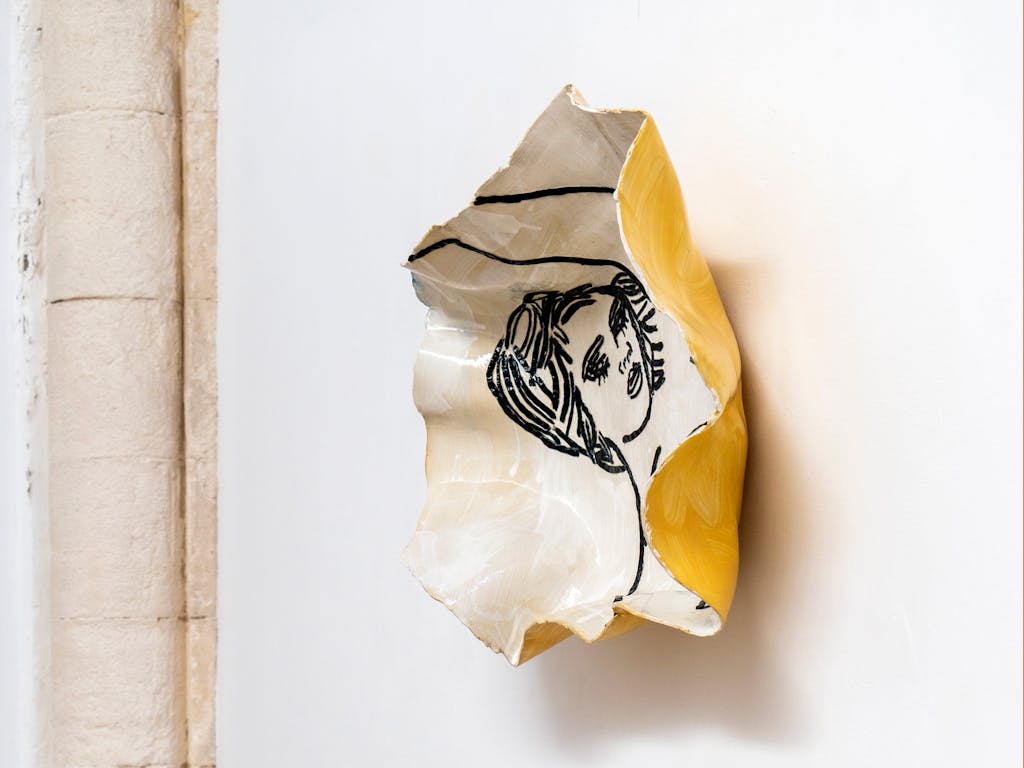In 2013, Ghada Amer began working with ceramic. She soon discovered that this new artistic language freed her from the constraints of painting (with a capital P) and its history. It granted her unexpected creative license to explore, experiment, and produce works with newfound freedom and joy. Color became a key element in her ceramics, just as it is in her paintings and other works. Initially, Amer struggled to create colored ceramic sculptures because she could not see the final color until the pieces were fired. However, she eventually developed techniques to overcome this challenge, enabling her to produce ceramic works marked by line drawings reminiscent of her signature paintings:
“I have a painterly approach when working with ceramics because I can produce colored sculptures. I have always attached great importance to the relationship between sculpture and color.”
Amer’s ceramic works explore themes familiar from her painted canvases. Once again, the artist questions notions of eroticism, femininity, and gender stereotypes. The naked torso of a reclining girl ("Reclining Girl"), the two women lost in an intimate embrace ("Blue Passion" and "Remembering the Boogie Woogie"), and the direct gaze of a young woman with her hair falling over her bare shoulder ("Coco" and "A Red Smile") all reflect the erotic aesthetics of Amer’s work, while also probing the complexity of femininity and challenging simplistic patriarchal gender binaries.
Painting and color—whether expressed through ceramics or canvases—are central to Amer's creative process. As an MFA student at Villa Arson in France in the late 1980s, she was barred from painting classes because the professor at the time only accepted male students. Since then, painting has become Amer’s signature act of rebellion against male-dominated artistic and cultural productions. She developed a new pictorial language that addresses and resists the systemic erasure of women from art history. Sewing—a craft traditionally associated with women—became her tool of defiance, a starting point from which she developed a body of work questioning power structures. Sewing with needle and thread became her feminine and feminist equivalent of paint and brush, allowing her to "paint" in her own way.
This exhibition also features a selection from Amer’s most abstract and experimental series, "Thoughts." As she chiseled clay with her dominant hand, she collected excess clay in her left, creating art from the discarded scraps. The resulting assemblages of noodly strips form improvised, surreal visual explorations. These pieces are a joyful celebration of pure form and color, offering a playful exploration of the materiality of clay.
Finally, "Playing with Mud" introduces new works on canvas from Amer’s most recent series, "QR Codes Revisited." In this series, the artist revisits an ancient Egyptian textile tradition, which uses brightly colored panels to decorate interiors. She transforms these traditionally masculine compositions into abstract grids of geometric patterns, recalling the angular shapes of QR codes. The dichotomy between the abstract shapes of the QR codes and the materiality of textiles is deepened by the texts traced on each canvas. Viewers can read quotes (translated into English) from French feminist Simone de Beauvoir, Egyptian feminist and activist Nawal El-Saadawi, and American political activist Malcolm X. These quotations highlight the social, political, and feminist concerns at the heart of Ghada Amer’s artistic project, inviting reflection and challenging simplistic East-West dichotomies. Under her expert hands, QR codes become an abstract, feminist, and political language.
Ghada Amer (b. 1963, Cairo, Egypt) lives and works in New York. Her most recent institutional exhibitions include shows at the Barbican in London, UK (2024), the Centre Pompidou Metz, France (2024), and the MUCEM, Marseille, France (2023). Amer’s works are part of major public collections, including the Art Institute of Chicago; the Centre Pompidou, Paris; the Detroit Institute of Arts; the Guggenheim Museum, Abu Dhabi; the Kunstpalast, Düsseldorf; and the Sammlung Goetz, Munich.
This exhibition is supported by Consell de Mallorca.
